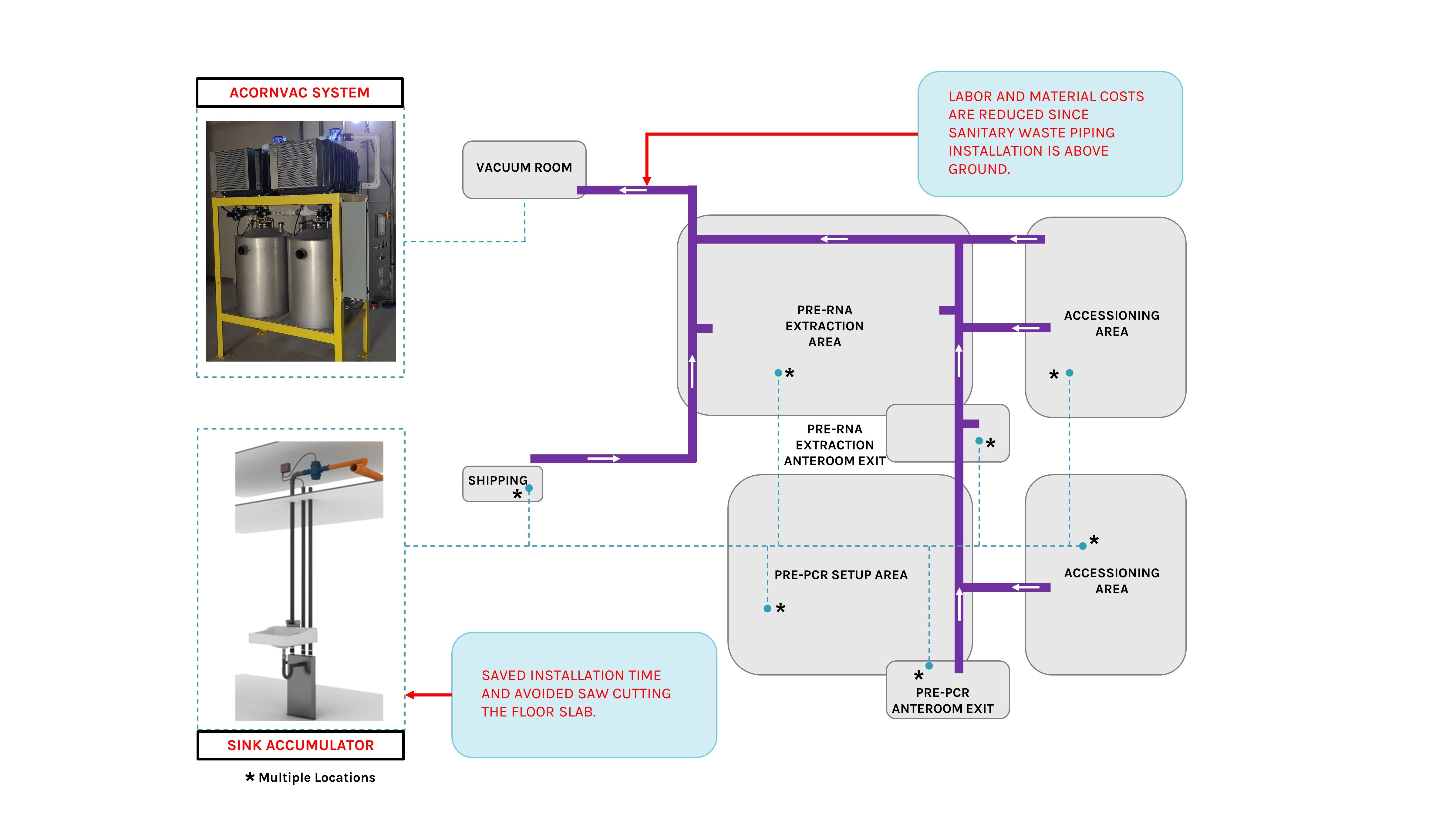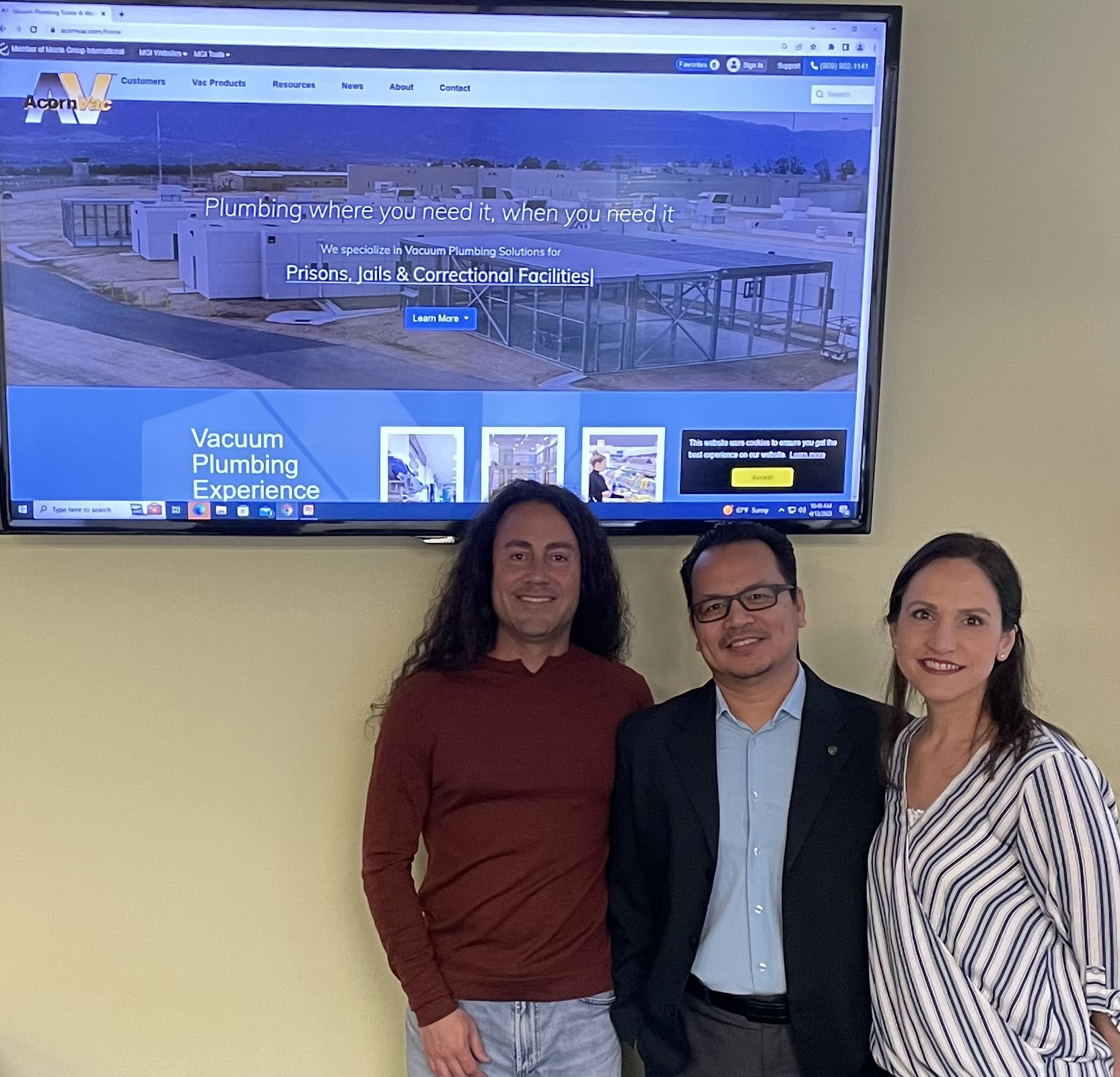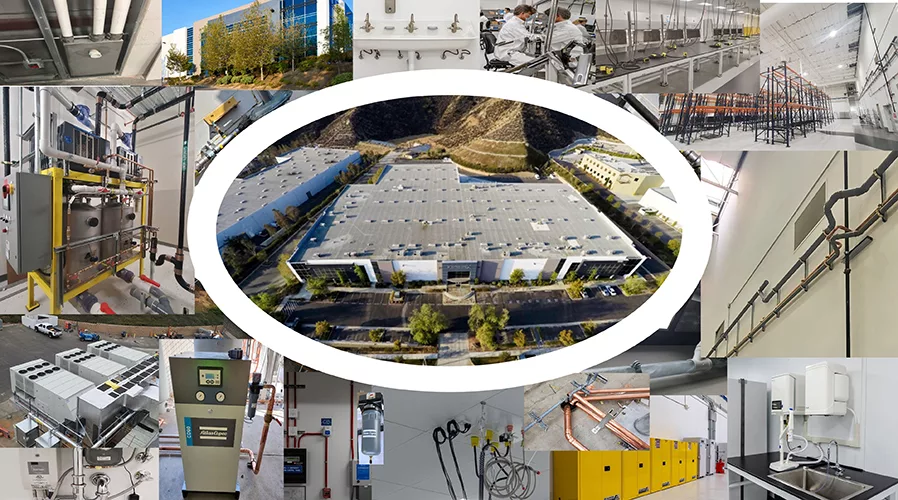This year, Plumbing Engineer created its inaugural Plumbing Design of the Year competition, a readers’ choice honor chosen by the readers and followers of PHCPPros.com. Four engineering firms answered the call to action and threw their hats in the ring by submitting projects they deemed worthy of this recognition. We are happy to announce that this year’s project winner is from SmithGroup.
Time was of the essence for the buildout of the Valencia COVID-19 Testing Facility, which was completed within eight weeks and used a unique system to complete the project in a timely fashion at a time when the world was filled with uncertainty.
I had the opportunity to meet up with two of the plumbing engineering team members when they came to Chicago recently. During our visit, Jose Alicea, EIT, senior plumbing designer, and Lowell Manalo, plumbing discipline lead and principal, spoke with me about the unique aspects of this project.
Manalo explains that although SmithGroup designs and specifies a wide range of plumbing projects, it submitted the Valencia COVID-19 Testing Facility due to the recent pandemic and the demanding schedule required to meet the needs of California COVID-19 testing.
This project was executed by California’s Department of General Services under an emergency order.
|
FIRM: SmithGroup PLUMBING ENGINEERING TEAM: • Jose Alicea, EIT, senior plumbing designer • Lowell Manalo, plumbing discipline lead, principal • Don Posson, PE, CCP, CPD, GGP, LEED AP, vice president WINNING PROJECT: California Department of General Services (DGS) – Valencia COVID-19 Testing Facility (Valencia, California) SIZE: 135,000 SF PROJECT COST: $22.6 million LOCATION: Valencia, California |
“Speed was everything for this project,” Manalo says. “The process pushed design-build beyond industry norms, from processing submittals to executing from details sketched on site. We had daily team huddles — both virtual and in-person. The project was an exercise in cooperation, trust and improvisation.”
Working during the pandemic also provided unique challenges, he explains: “On-site collaboration was crucial to maintain the pace of continuous construction through that period. Exercising precautions and balancing personal risks were constant reminders of the project’s very purpose and urgency. A fast design and construction process yielded an immediate impact on the community and had a significant impact on health and wellness during a global pandemic.”
Read on to learn about the project in greater detail and gain insights from the project team members.
The Project
The California Department of General Services selected the design/build team of Hensel Phelps/SmithGroup to provide full design services for a COVID-19 Testing Facility for the state, with the contracted goal to process 150,000 samples a day with a 24-to-48-hour turnaround time. The team was tasked to convert an existing 134,000-square-foot warehouse into a fully functional testing site in eight weeks using a progressive design-build delivery method.
The existing two-story warehouse consisted of an expansive open floor plan on the ground level, which was previously used as an industrial space surrounded by offices, restrooms and shower/locker room facilities. The laboratory’s function necessitated dividing the existing open area into several control areas, including receiving and staging areas, accessioning, pre-PCR (polymerase chain reaction) setup and pre-RNA (ribonucleic acid) extraction — the latter being a higher containment lab, which was designated as a box-within-a-box.
All the various plumbing systems, including fully redundant lab air systems delivering clean dry air, water heaters, sinks and fixtures needed to be procured, installed and commissioned within this eight-week time frame. This necessitated working hand in hand with the contractors on daily calls and on-site support to meet the project goals. Even with daily coordination, traditional construction methods limited the viability of completing the project within the allotted schedule.
“[The project] was an opportunity to present innovative ideas to maintain the construction schedule and streamline procurement and installation,” Alicea notes. “A unique aspect of this project was the ability to use our consulting expertise to meet the project goals. This included thinking about ways to leverage innovative materials and systems to deliver a high-functioning laboratory.”
Another interesting aspect of the project was that this new laboratory was designed within an existing industrial warehouse, he adds. “FARO Technologies was used to create point clouds of the existing building, including the MEP systems. Using an accurate three-dimensional spatial model was instrumental in designing the first time accurately.”
The Secret Sauce
On most projects, the first plumbing systems installed is the below-slab piping, such as the waste piping. To properly install that gravity piping, all the above-slab layouts must be planned out and identified. This coordination delays the start of the below-slab work. Using traditional installation methods, the below-slab installation with its saw-cutting and dust generation greatly limits the other work that can be done at the same time. Given the aggressive timeline for a fully functioning, commissioned facility, a traditional approach for waste piping was not viable.
This presented the team with an opportunity to employ an innovative plumbing vacuum system allowing construction to commence concurrent with the lab space programming. Since all the waste piping was routed overhead without a single slab cut, the design marched forward while the contractors began other onsite preparations. If the detailed coordination of plumbing systems in walls could be minimized, then the contractors could start framing walls and other features with little or no delay.
The “heart” of the innovative system is the AcornVac vacuum center. It includes the vacuum pumps and controls systems that allow the system to pull all the waste piping throughout the building without relying on a gravity piping, which only slopes downhill and requires trenching piping below the building slab. Without relying on gravity, overhead waste piping is installed on a common support system with other utilities, simplifying coordination by creating system utility corridors at a consistent elevation. (See Figure 3.)

The Laboratory Air and Other Plumbing Systems
While the existing facility already had auxiliary functional spaces such as a breakroom, several multi-fixture restrooms and shower/locker areas, several additional plumbing systems were needed to make this a viable COVID test-processing facility. A large effort of this project involved determining how to provide systems that can reliably operate continuously 24/7 while also being available to be installed and commissioned within the eight-week window from award to start of operations.
To give an overall perspective of mechanical, electrical and plumbing (MEP) systems, a new 1,500 kW standby generator, uninterruptible power supply (UPS) room equipment, air-handling units, oil-free air compressors (including dryers and receiver tanks), plumbing vacuum system and water heaters were all installed.
“All these systems were started-up and tested concurrent with the lab equipment installation during the final stages of the project,” Alicea explains. “It was truly exhilarating!”
To meet the required air change rates for the labs, three new 20,000 cubic foot/minute air-handling units were provided south of the building, displacing eight existing parking stalls.
Electrical engineers performed an analysis of the building’s electrical infrastructure. Given the electrical service size limitation and proposed laboratory and MEP systems being deployed, there was no additional electrical capacity for heating. This necessitated using the building’s existing medium pressure gas service for space heating, which required coordination with the gas utility to ensure adequate capacity without having to request an upgrade to the service size.
Medium-pressure gas piping was routed along the roof from where the existing service was located to the opposite side of the building to connect to the new air-handling units. A pressure regulator was added in the vicinity of the air-handling units to reduce to low pressure (7 to 14-inch water column). Routing the gas piping on the roof minimized coordination needed, as compared to running through the active construction zone.
A large percentage of the testing equipment within the facility required clean dry air to operate. A new lab air system consisted of two oil-free Class 0 8573-1 certified rotary air compressors with variable-speed drives on the lead compressor, desiccant dryers, and wet and dry receiver tanks. The outdoor compressors were located on grade adjacent to the building with shading to protect the equipment from direct exposure to the weather.
Placing the equipment outside also minimized impacts to other disciplines and increased cooling load to mechanical systems. From the air compressor, lab-quality air distribution is run inside the building to the pre-RNA extraction department. Lab air in the pre-RNA extraction area is delivered to equipment via ceiling service panels.
Domestic cold water piping was extended and distributed to serve the emergency fixtures and sinks in the shipping, breakroom, pre-PCR, pre-RNA and accessioning areas. The domestic cold water also was routed outside the building to connect to the air-handling unit humidifiers with integral backflow preventors. Sinks in the pre-PCR and accessioning areas use point-of-use instantaneous water heaters for faster installation and delivery of hot water.
New wall-hung and ducted high-static-type fan coil units were provided to serve the UPS, pre-RNA extraction, restrooms, locker, breakroom and document control room. Condensate drains from the fan-coil units are collected and strategically discharged to the termination point, minimizing the piping runs as much as possible. To expedite piping installation, all newly installed copper-piped systems including domestic water and lab air used Viega ProPress fittings. Viega MegaPress was used for steel gas piping.
Although the open warehouse area where the build-out occurred did have waste piping infrastructure below slab, identifying fixture locations at such an early stage in design presents challenges. Due to the complexity of the lab spaces and time needed for planning, a different approach allowed design to be concurrent with construction. Planning had already identified the boundaries to the various labs in the program and framing the walls began within days of the notice to proceed being given.
Given concurrent design and construction together with the limited window to be operational, SmithGroup determined this project would be an excellent candidate for a plumbing vacuum system, in which all the waste from lab fixtures is routed overhead, similar to other hydronic systems that do not rely on gravity.
This approach was paramount as large portions of the program design were in its infancy.
“As soon as the space blocking was finalized, wall framing started without having to finalize sink locations,” Alicea says. “Plumbing vacuum systems provide a clear benefit as they allow flexibility to install and move fixtures without disturbing the building slab. With no saw-cutting or earth work, all lab waste and vent piping were routed entirely overhead, providing a tremendous speed advantage.”
Since plumbing vacuum systems draw the effluent under suction, the standard rules of maintaining a consistent downward slope do not apply. For example, the overhead vacuum waste piping can be configured to route around obstructions including going up and over large ducts and structural members.
This allows a much greater level of flexibility to place fixtures where not typically feasible. Fixtures can not only be installed in locations where a gravity waste system would be complex, relocating fixtures and even adding fixtures becomes dramatically simpler. Adding sinks requires no saw-cutting to get to the buried waste piping and can be piped and connected to the existing overhead vacuum plumbing infrastructure — all while routing around existing systems. (See Figure 4.)

Once completed, the Valencia COVID-19 Testing Facility remained operational for two years — from October 2020 through 2022 — and processed millions of COVID tests for the state of California.
Post-Project Reflections
Alicea, who has worked in the consulting industry for more than 18 years, understands what it takes to deliver service beyond expectations, from conceptualization to completion and at all stages between, working on an extensive range of products within the commercial, educational, health care, and science and technologies sectors.
As such, he worked closely with subcontractors and was involved in this project’s plumbing design and construction administration aspects. Alicea offers takeaways on this year’s plumbing design of the year.
Plumbing Engineer: What were the most challenging aspects of the job?
Jose Alicea: The sheer speed of the construction schedule posed an exciting and welcome challenge to every team member. We started each day with an all-hands meeting to ensure that all involved would understand how the design and construction were progressing and anything posing a risk was identified and addressed.
As design professionals, we all know how much of a challenge a demanding construction schedule can be for all trades. It was a memorable experience, and the team has much to be proud of for this accomplishment.
PE: Any lessons learned while working on the project?
JA: Our progressive design-build partner Hensel Phelps worked seamlessly with our team and their subcontractors, and highlighted the value of effective communication and keeping the team pointed toward a shared goal.
PE: What recommendations would you give to a PE firm tasked with working under a deadline?
JA: The importance of communication in a fast-paced project such as this cannot be underestimated. Creating a project timeline and emphasizing how critical it is for all team members to be proactive with identifying their needs, effectively relaying what is being delivered, and ensuring that they are being issued when commitments are made.
PE: Were any sustainable elements put into the project?
JA: Although this project did not specifically focus on sustainability, it does include significant water savings. Plumbing vacuum systems operate under negative pressure to draw waste from the fixtures. Water closets for these systems flush with half a gallon of water per flush or less. Compared to modern toilets, which typically use 1.28 gallons per flush, this type of system provides huge savings.
PE: How does it feel to have your project win Plumbing Engineer’s inaugural Plumbing Design of the Year contest?
Lowell Manalo & JA: We are honored to be named the first winner of this contest, especially given the quality of the other entries. Recognition like this provides another tool to advance how vital plumbing is in the design industry.

PE: Is there anything you’d like to add?
LM: We want to congratulate the other projects that were also highlighted in this competition. These are outstanding projects in their own right, and we can continue to push each other to elevate the plumbing design industry together.
Plumbing and sanitary sewer systems play a vital role in the history of humanity. Modern buildings or homes are only able to function safely with adequately designed plumbing systems. Plumbing systems provide safety, comfort and convenience. More than ever, we must be grateful and work together to advance plumbing design and processes for the rest of the world.
Editor’s Note: A special thank you to team members Lowell Manalo and Jose Alicea, who provided the technical details on this project and helped complete the article on a tight deadline.
Lowell Manalo is the plumbing discipline leader and principal at SmithGroup. He is a member of the American Society of Plumbing Engineers and has more than 20 years of experience designing plumbing systems for various building types.
Jose Alicea is a senior plumbing designer at SmithGroup’s San Diego office. He has 18-plus years of experience designing plumbing systems for various building types.






